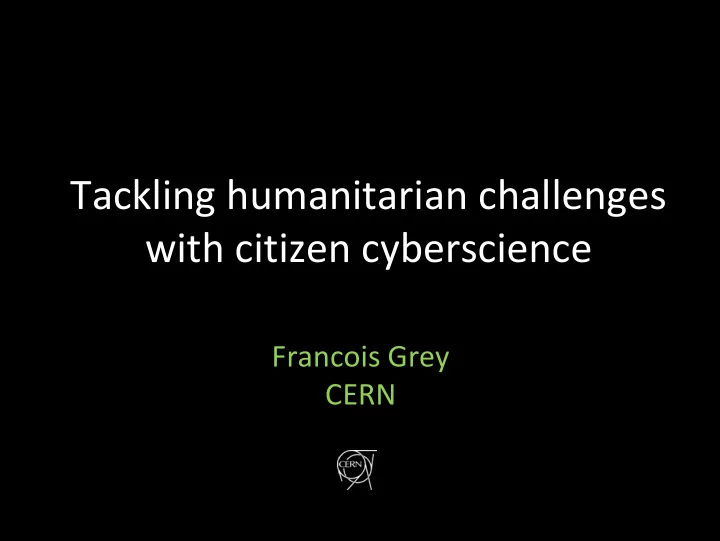

Tackling humanitarian challenges with citizen cyberscience Francois Grey CERN
SETI@home: >500,000 CPUs “Poor man’s Grid” BOINC (Berkeley Open Infrastructure for Network Computing) platform launched in 2003. General ‐ purpose open ‐ source platform for client ‐ server model of distributed computing. >50 volunteer computing projects today in a wide range of sciences. Not all use BOINC.
Folding@home: >1 petaflop Sony pre ‐ installs folding@home on Playstation ‐ III – user can choose to run in background. 50k PS3s make first distributed petaflop machine (Guiness World Record Sept 2007).
LHC@home: >3000 CPU ‐ years Fortran program Sixtrack simulates LHC proton beam stability for 10 5 ‐ 10 6 orbits. Include real magnet parameters, beam ‐ beam effects. Predict stable operation conditions.
BOINC: keep the volunteers happy Cool screensaver Message boards =social networking Credit for processing = massively multiplayer online game
citizen cyberscience: from volunteer computing to volunteer thinking
Wim Klein: the first computer at CERN
scientists!
GalaxyZoo: classify galaxies
Herbaria@home: digitize 19 th century plant archives
citizen cyberscience for humanitarian challenges in Africa
Africa@home: empower African scientists Partnership: CERN, Swiss Tropical Institute, Uni. Geneva, World Health Org, 2 NGOs Africa@home workshops: >50 African scientists from 20 countries (South Africa, Mali) Africa@home projects: MalariaControl.net, HIVMM, AfricaMap, Autodock (w. HealthGrid) Africa@home servers: Uni. Cape Town, Uni. Geneva
MalariaControl.net: modeling the spread of the disease STI population model: Individuals (humans, mosquitoes) with properties (age, immunity…) and interactions (infect…) Evolve model, observe results, adjust parameters, repeat to fit field data (deaths, $ spent…)
MalariaControl.net: scientific results 1 0.8 0.6 0.4 0.2 Sugungum 1 Prevalence 0.8 0.6 0.4 0.2 Matsari 1 0.8 0.6 0.4 0.2 Namawala 0.1 1 2 5 10 20 50 Age (years) 14 articles on STI model published in Am. J. Trop. Med. Hyg., 75 (supplement), 2006. Volunteer computing enables detailed models, more parameters, projecting future scenarios.
MalariaControl.net: health impact STI model predictions of cost ‐ effectiveness: Vaccine $1 ‐ $10 per dose with 52% efficacy = $4.73 ‐ $34.43 per fully ‐ immunized child = $450 ‐ $3,500 per death averted = $12 ‐ $96 per disability adjusted life year = $2.7M ‐ $19.8M per year for Mozambique • STI data reviewed by PATH Malaria Vaccine Initiative with stakeholders in Mozambique. • Instrumental in Mozambique now planning for possible future use of a malaria vaccine.
Who are the volunteers? 8500 active volunteers and 15,000 hosts in 123 countries, growing at 50 volunteers/day
AfricaMap: cartography from satellite images BOSSA: open ‐ source software platform for volunteer thinking projects BOLT: toolkit for web ‐ based training and education
The future: citizen cyberscience by Asian scientists for Asian challenges with worldwide volunteers
Recommend
More recommend